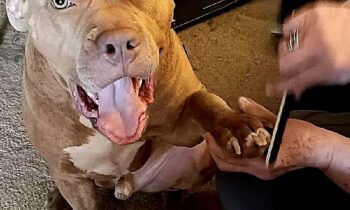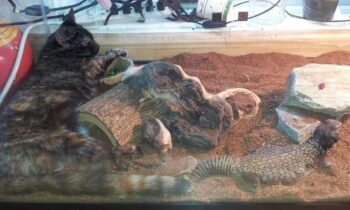
Can you raise a puppy without allowing her to be rewarded by successfully stealing food? What about an adult dog who’s experienced repeated success at counter-surfing? He’s been rewarded for food-stealing behavior so many times! How do you eliminate counter-surfing and stealing food from the repertoire of a repeat offender?
I asked dog owners and dog professionals for their suggestions on discouraging and preventing counter-surfing and other food-stealing behaviors in puppies and adult dogs. What’s worked for them with their own dogs, and what do they recommend to clients?
Eileen M Gillan I go with the lazy option: Keep the counters clear. Use the microwave if you need a place to store something temporarily.
Leonard Buzz Cecil Clean off the frigging counter. I just shake my head in disbelief when a client says some version of “That won’t work.”
Donna Weidert I had the sweetest, sneakiest spaniel about 15 years ago. She was the worst counter/table thief I have ever seen. It’s not very original or clever, but the only thing that worked consistently was a baby gate in the kitchen doorway. We got one with a walk-through option, which made it easy to navigate. Shelby was not allowed in the kitchen.
Colette Kase Many, many, many years ago, I had a bad accident in the kitchen when I tripped over my dog and spilled hot fat onto his back. [It] was an unfortunate lesson that I will never forget. Normally now, the rule in the house is no dogs are allowed in the kitchen if there is a person in the kitchen. If there is not a person in the kitchen, then there is no food anywhere the dogs can get it. That also has to be a house rule. Right now, we are in a rented house with a very, very elderly dog, so that rule has sort of gone out the window. Her eyesight isn’t that great and she’s not very fast, so it’s really up to us to make sure that she’s not going to be stepped on or tripped over.
Clair Eccles (1) Completely keep all surfaces clear. (2) Put food right at the back of the worktop. When the dog keeps all paws on the floor, I click/treat. Follow this up by bringing [the food] closer to the edge of the worktop, click the disengagement, and throw food at my dogs. I have trained seven out of my eight this way but one (a husky) still has to steal the butter every time my parents come over and leave it out!
Denise O’Moore I use “treat mats.” Dog goes to mat and I’m in between them and the counter when prepping food. If all four paws are on the mat, they get something. If I’m not there, it’s a clear counter. [My dog] did move his treat mat [closer] to the counter at one point but just sat there. In all fairness, he was on the mat! I forgot [he] had a PhD in counter-surfing and ran to answer the door, leaving on the counter a chicken I was prepping for the dogs. He had worked so hard at sitting on the mat [and] it paid off. (Okay, two paws were on the floor, but he didn’t move.)

Photo by Denise O’Moore
Stephanie Day Dog never receives treats in kitchen unless she’s on her mat (in the kitchen). Going to the mat is a heavily reinforced and practiced behavior. Jumping on the counter results in a request to “go to your mat.” She hangs out on that mat when nobody’s in the kitchen.
Chelsea Edwards For my household, I have had the greatest success with simply keeping counters clear.
Second greatest success (and usually in combination with first and third) is to use gates, doors, or whatever to block kitchen access.
Third, I teach [that] the kitchen is a no-dog zone when there is any activity, and I don’t keep food/water bowls in the kitchen.
For clients, I recommend whatever version of these things applies best to their particular environment. It could also include mat training, using enrichment, or teaching another incompatible behavior, but the first option is always the most successful: keep the counters clear.
Depending upon the layout, I use place mats or trays under water bowls and set them up at various points in the house. Currently we have three water stations that punctuate different parts of the house; it’s a shotgun style. I don’t feed in bowls, so I can give a KONG or similar feeding vessel anywhere, and some dogs eat in their crates.
I use feeding time to help reinforce “no kitchen access” by only giving meals or even treats not in the kitchen. I work to never give food reinforcement in the kitchen.
This has worked well for me and my dogs/style, but there are variations that do include alternatives like teaching dogs to snuffle the floor instead of the counters. If clients require a different method, we work together to figure out what works.
But, again, there is just no substitute for keeping the counters clear.
Frania Shelley-Grielen In addition to the classic approach of (1) Removing punishment, (2) Managing the environment, and (3) Training/behavior modification—make sure that the third step is meaningful in not just teaching what you want, but in also satisfying what your dog needs. A hungry/curious dog would like that food on the counter partly because it is so very yummy and appealing. Feeding a truly high-quality diet satisfies on more than just a nutritional level. Feeding your dog’s diet in a food puzzle satisfies behavioral needs and prolongs the dining experience so food is not just gulped down, finished, over.
I would very much like to give credit for an idea that could be easily incorporated with any or all of the basics outlined in the suggestions above, but unfortunately I do not know its source. This idea is very simple:
▪ On the counter in your kitchen, secure a box in which you can place all the food items and/or objects you need nearby while you’re working there. It isn’t permanent storage, it’s temporary safe storage only. Call it The XXX Box (your dog’s name there) after your counter-surfer.
▪ Teach yourself to use that box every time you are in the kitchen.
▪ Use it even for non-food items you might set down for a second.
▪ Latch it securely every single time you close it—no exceptions!
Using the temporary safe storage of The XXX Box consistently, you can augment your training and management plans by guaranteeing that nothing is available for your counter-surfer to steal. Teaching yourself to use the box will be the hard part. Model that behavior for the rest of the family, and don’t forget to notice and to encourage it when others use the box properly, too!
One more suggestion—bell your dog.
Counter-surfers successfully steal food and objects because they can. They can because no one is watching them closely enough to do anything about it! Security cameras aimed at counters might help, but someone would have to be monitoring them. Instead, how about an inexpensive low-tech solution for keeping track of where your dog is in your home? Attach a bell securely to your dog’s collar.
Be safe about it.
▪ Choose a bell that’s big enough your dog can’t swallow it.
▪ Attach the bell to a clip so you can take it off the collar easily.
▪ Don’t leave the bell on your dog when you’re not home.
▪ Remember to let your dog get used to the sound before you attach the bell to his collar.
Listening to a bell ringing whenever a dog moves may be annoying, but it also can make it easier for you to pay attention to where your dog is and what your dog is doing wherever the dog is in your home or yard.
Use that awareness wisely. Call the dog to you often and reward the dog with whatever you know the dog will find the most valuable at the moment—a treat, a game, a hug.



